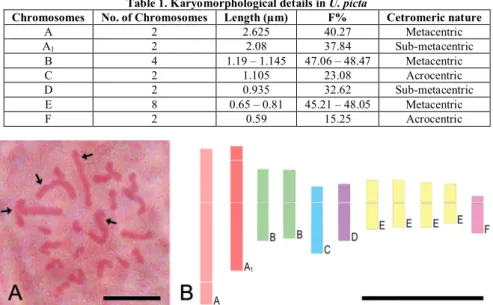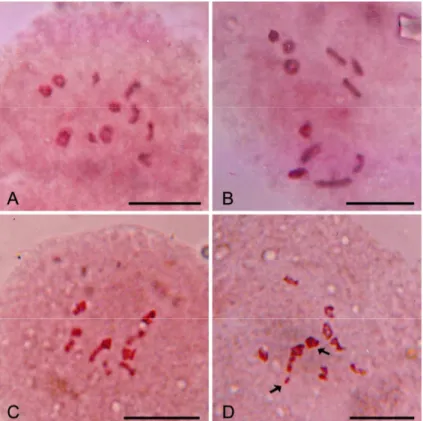Datta K. Animesh et al. IRJP 2012, 3 (7)
Page 162
INTERNATIONAL RESEARCH JOURNAL OF PHARMACY
www.irjponline.com
ISSN 2230
–
8407
Research Article
KARYOMORPHOLOGY AND CHROMOSOME NUMBER CONFIRMATION IN
URARIA PICTA
(JACQ.) DC.
Bhattacharya Arnab and Datta K. Animesh*
Department of Botany, Cytogenetics and Plant Breeding Section, University of Kalyani, Kalyani – 741235, West Bengal, India
Article Received on: 10/04/12 Revised on: 23/05/12 Approved for publication: 16/06/12
*Dr. Animesh K. Datta, Professor, Department of Botany, Cytogenetics and Plant Breeding Section, University of Kalyani, Kalyani – 741235, West Bengal, India Email: dattaanimesh@gmail.com
ABSTRACT
Karyomorphological studies performed in Uraria picta (Jacq.) DC. (Family: Leguminosae, Subfamily: Papillionidae), an important Ayurvedic herb (Ayurvedic name: Prishni parni), revealed 7 (2n = 22; 2Ls
m + 2Lscsm + 4Mm + 2Msac + 2Ssm + 8Sm + 2Sac) morphologically distinct chromosome types. The
chromosomes in the species were graded (long: L - ≥ 2.0µm; medium: M - ≥ 1.0µm; small: S - < 1.0µm) on the basis of absolute chromosome length (0.59µm to 2.625µm). The karyotype showed preponderance of chromosomes with metacentric (m) primary constrictions; although, it was asymmetric in nature (TF%: 37.65). Total haploid chromosome length was noted to be 12.63µm ± 3.73. Two pairs of chromosomes in the complement were with secondary constrictions and they were associated both with short as well as long arms. The chromosome number (2n = 22) analyzed in root tip mitosis was in agreement to the number noted in microsporocytes (n = 11). The confirmed number in the species is 2n = 22.
KEYWORDS: Uraria picta, Karyomorphology, meiotic analysis chromosome number confirmation.
INTRODUCTION
Uraria picta (Jacq.) DC. (Family: Leguminosae; Subfamily: Papillionidae) is an important herb (also reported to be a woody herb1, a perennial herb2-3 and a shrub4) in Ayurvedic (Ayurvedic name: Prishni parni) medicine (used parts: roots/leaves/whole plant)5-8. The chromosome number is reported to be variable (n = 11 4, 9-11; 2n = 1612; 2n = 20 in the genus Uraria13) in the species; although, chromosome number alone does not provide any cytogenetical information which may be used to design breeding strategies for crop improvement. The present communication reports on the karyomorphology of U. picta, which is previously undescribed, with an objective to collect cytological information for efficient breeding. The chromosome number recorded in root tip mitosis was also confirmed from meiotic preparations. Although, cytological studies are rather meager in Ayurvedic plant species14-16, they often carry a wealth of information for breeders, geneticists and other researchers. MATERIALS AND METHODS
Root tips (generated from pre-soaked petri plate germinated seeds of Uraria picta; seed samples were collected from Medicinal Plant Garden, Narendrapur, Ramkrishna Mission, Govt. of West Bengal) of about 2.0 to 3.0mm length were pretreated in 0.1% colchicine for 3 hours 30 mins (room temperature – 33.0°C ± 1.0°C) washed in distilled water and kept in 0.01M KCl: 0.005M NaCl mixture (3:1) for overnight before fixing in 70.0% alchohol and storage under refrigeration. The root tips were stained in 4.0% aceto-orcein: 4N HCl mixture (9:2) for 2 hours and finally squashed in 45.0% acetic acid and observed under the microscope. Suitable metaphase plates (3 properly and uniformly condensed) were scored and measurements of the chromosomes were taken from camera lucida drawings at the magnification of 20×100x.
The centromeric nature in the chromosomes were classified as metacentric (m), sub-metacentric (sm), sub-acrocentric (sac) and acrocentric (ac) in accordance to Hirahara and Tatuno17. On the basis of chromosome length (long: L - ≥
2.0µm; medium: M - ≥ 1.0µm; small: S - < 1.0µm), centromeric position and the presence of secondary constriction (sc), the chromosomes were morphologically graded: type A: long metacentric chromosomes with secondary constrictions associated to short arm, type A1: long
sub-metacentric chromosomes with satellites and it is with long arm, type B: medium sized chromosomes possessing metacentric primary constrictions, type C: medium sized chromosomes with sub-acrocentric primary constrictions, type D: small sub-metacentric chromosome, type E: small metacentric chromosomes and type F: small chromosomes with acrocentric primary constrictions. Total haploid chromatin length, TF% (proportion of short arm in the total chromatin length) and S% (relative length of shortest chromosomes compared to the longest) were also analyzed. Karyomorphological data was used to compute karyotype formula.
Meiotic chromosome preparations were made as was suggested by Bhattacharya and Datta11, 18. Microphotographs for both mitotic and meiotic chromosomes were taken from temporary squash preparations and subsequently magnified. RESULTS AND DISCUSSION
Karyomorphological studies revealed 7 (2n = 22; 2Lsm +
2Lscsm + 4Mm + 2Msac + 2Ssm + 8Sm + 2Sac) morphologically
distinct chromosome types (Table 1, Fig 1.A-B). The karyotype showed prevalence of chromosomes (14 out of 22) with metacentric primary constrictions (F%: 40.27 to 48.47); although, 4 chromosomes with sub-metacentric (F%: 32.62 to 37.84), 2 with sub-acrocentric (F%: 23.08) and 2 with acrocentric (F%: 15.25) constrictions were also present. Absolute chromosome length in the complement ranged from 0.59µm to 2.625µm. Two pairs of long chromosomes (2.08µm to 2.625µm) were with satellites and the satellites were associated with both the short arm (type A1) as well as
Datta K. Animesh et al. IRJP 2012, 3 (7)
Page 163
Meiotic analysis revealed (study performed for 3 consecutive years in 3 to 5 randomly selected plants every year; data pooled over the plants) 2n = 22 chromosomes (1st year – 0.11 IV + 10.29 II + 0.98 I, 236 cells scored; 2nd year - 0.16 IV + 10.78 II + 0.98 I, 182 PMCs analyzed; 3rd year -0.14 IV + 10.63 II + 0.96 I, 164 meiocytes studied) always at metaphase I (Fig. 2.A-D) and anaphase I (all cells were cytologically balanced – 11/11 separation of chromosomes). This result is in conformity to the chromosome number observed in root tip mitosis, and therefore chromosome number in the species is 2n = 22 as suggested earlier (n = 11,
x = 6) by Bhattacharya and Datta11.
REFERENCES
1. Okusanya OT, Lakanmi OO, Oyesiku OO. Germination ecology of the woody herb Uraria picta, from southern Nigeria. J Trop Ecol. 1991; 7: 139-46.
2. Anand A, Rao CS, Latha R, Josekutty PC, Balakrishna P. Micropropagation of Uraria picta, a medicinal plant through axillary bud culture and callus regeneration. In-Vitro Cell Dev Biol. 1988; 32: 136-140
3. Rahman MM, Gibbons S, Alexander IG Isoflavanones from Uraria picta and their antimicrobial activity. Phytochemistry. 2007; 68:1692– 1697.
4. Gill LS, Husaini SW. Cytological observations in Leguminosae from Southern Nigeria. Willdenowia. 1986; 15:521-527.
5. Allen ON, Allen EK. The Leguminosae, a source book of characteristics, uses, and nodulation. University of Wisconsin Press, Madison, Wisc.; 1981. p. 672-673.
6. Jain SK, Defillips R. Medicinal Plants of India. Reference Publication, Alogonal, Michigan, U.S.A.; 1991. p. 372.
7. Kritikar KR, Basu BD. Indian Medicinal Plants. (Vol. I). International Book Distributors, Dehradun. 1995. p. 72, 308, 562. 8. Yusuf M, Chowdhury JU, Wahab MA, Begum J. Medicinal
Plants of Bangladesh, BCSIR Laboratories, Dhaka, Bangladesh, 1994. p: 441-443.
9. Miege J. Quatrieme liste de nombres chromosomiques d’especes d’Afrique Occidentale. Rev Cytol Biol Veg. 1962; 24: 149–164. 10. Bir SS, Kumari S. Evolutionary status of Leguminosae from
Pachmarhi, Central India. The Nucleus. 1977; 20: 94–98. 11. Bhattacharya A, Datta AK. Secondary chromosome association in
Uraria picta (Jacq.) DC (Family: Leguminosae). Cytologia. 2010; 75: 37-40.
12. Sanjappa M, Dasgupta A. In: IOPB chromosome number reports LVI. Taxon. 1977; 26: 257–274.
13. Pridgeon AM, Cribb PJ, Chase MW, Rasmussen FN. Genera Orchidacearum. (vol. 1, 2nd ed.) Oxford University Press, Oxford. 2003. p. 80.
14. Iqbal M, Datta AK. Cytogenetic studies in Withania somnifera (L.) Dun. (Solanaceae). Cytologia. 2007; 72: 43-47.
15. Datta AK, Saha A, Bhattacharya A, Mandal A, Paul R. et al. Black cumin (Nigella sativa L.) – A Review. J Plant Dev Sci. 2012; 4:1-43.
16. Samaddar T, Nath S, Halder M, Sil B, Roychowdhury D. et al. Karyotype analysis of three important traditional Indian medicinal plants, Bacopa monnieri, Tylophora indica and Withania somnifera. The Nucleus. 2012; 55: 17-20.
17. Hirahara S, Tatuno S. Cytological studies on Narcissus. I. Karyotype and nucleolinus of Narcissus jonquilla. Cytologia. 1967; 32: 553-559.
18. Bhattacharya A, Datta AK. A Report on Genetic Male Sterility in Uraria picta (Jacq.) DC. Cytologia. 2011; 76: 55-62.
Table 1. Karyomorphological details in U. picta
Chromosomes No. of Chromosomes Length (µm) F% Cetromeric nature
A 2 2.625 40.27 Metacentric
A1 2 2.08 37.84 Sub-metacentric
B 4 1.19 – 1.145 47.06 – 48.47 Metacentric
C 2 1.105 23.08 Acrocentric
D 2 0.935 32.62 Sub-metacentric
E 8 0.65 – 0.81 45.21 – 48.05 Metacentric
F 2 0.59 15.25 Acrocentric
Datta K. Animesh et al. IRJP 2012, 3 (7)
Page 164
Fig 2: Meiotic metaphase I. A-C- 11 II; D- 10 II + 2 I (univalents marked). Scale bar = 10.0 μm

